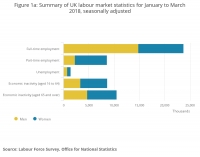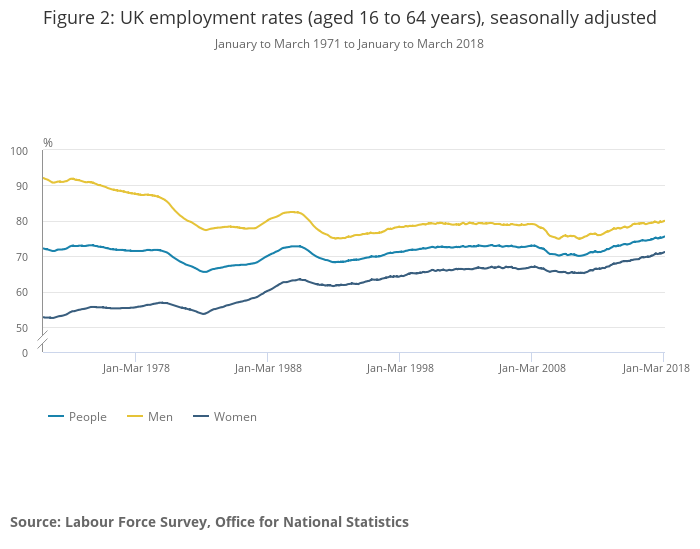Labour Force Survey Main Points for January To March 2018
Tuesday 15 May, 2018 Written by Simon Collyer
Estimates from the Labour Force Survey show that, between October to December 2017 and January to March 2018, the number of people in work increased, the number of unemployed people decreased and the number of people aged from 16 to 64 years not working and not seeking or available to work (economically inactive) also decreased.
There were 32.34 million people in work, 197,000 more than for October to December 2017 and 396,000 more than for a year earlier.
The employment rate (the proportion of people aged from 16 to 64 years who were in work) was 75.6%, higher than for a year earlier (74.8%) and the highest since comparable records began in 1971.
There were 1.42 million unemployed people (people not in work but seeking and available to work), 46,000 fewer than for October to December 2017 and 116,000 fewer than for a year earlier.
The unemployment rate (the proportion of people in work plus unemployed people, who were unemployed) was 4.2%, down from 4.6% for a year earlier and the joint lowest since 1975.
There were 8.66 million people aged from 16 to 64 years who were economically inactive (not working and not seeking or available to work), 115,000 fewer than for October to December 2017 and 171,000 fewer than for a year earlier.
The inactivity rate (the proportion of people aged from 16 to 64 years who were economically inactive) was 21.0%, lower than for a year earlier (21.5%) and the lowest since comparable records began in 1971.
Latest estimates show that average weekly earnings for employees in Great Britain in nominal terms (that is, not adjusted for price inflation) increased by 2.9% excluding bonuses, and by 2.6% including bonuses, compared with a year earlier.
Latest estimates show that average weekly earnings for employees in Great Britain in real terms (that is, adjusted for price inflation) increased by 0.4% excluding bonuses, but were unchanged including bonuses, compared with a year earlier.
Commenting on today’s labour market figures, senior ONS statistician Matt Hughes said: "With employment up again in the three months to March, the rate has hit a new record, with unemployment remaining at its lowest rate since 1975. “The growth in employment is still being driven by UK nationals, with a slight drop over the past year in the number of foreign workers. It’s important to remember, though, that this isn’t a measure of migration. “Growth in total pay remains in line with inflation, meaning real earnings are flat on the year.”

Leave a comment
Make sure you enter all the required information, indicated by an asterisk (*). HTML code is not allowed.
Join
FREE
Here










